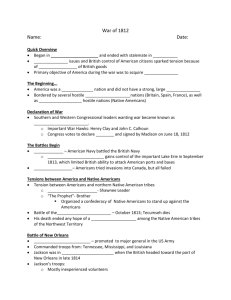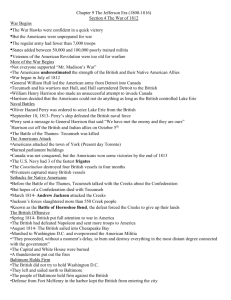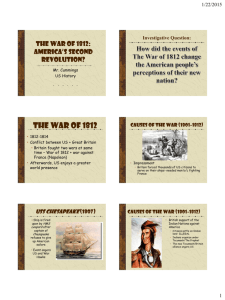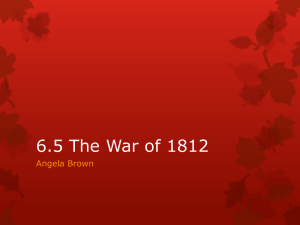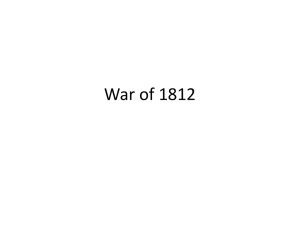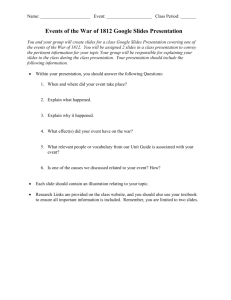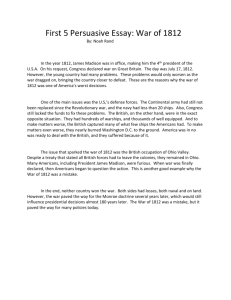The War of 1812 at Sea
advertisement
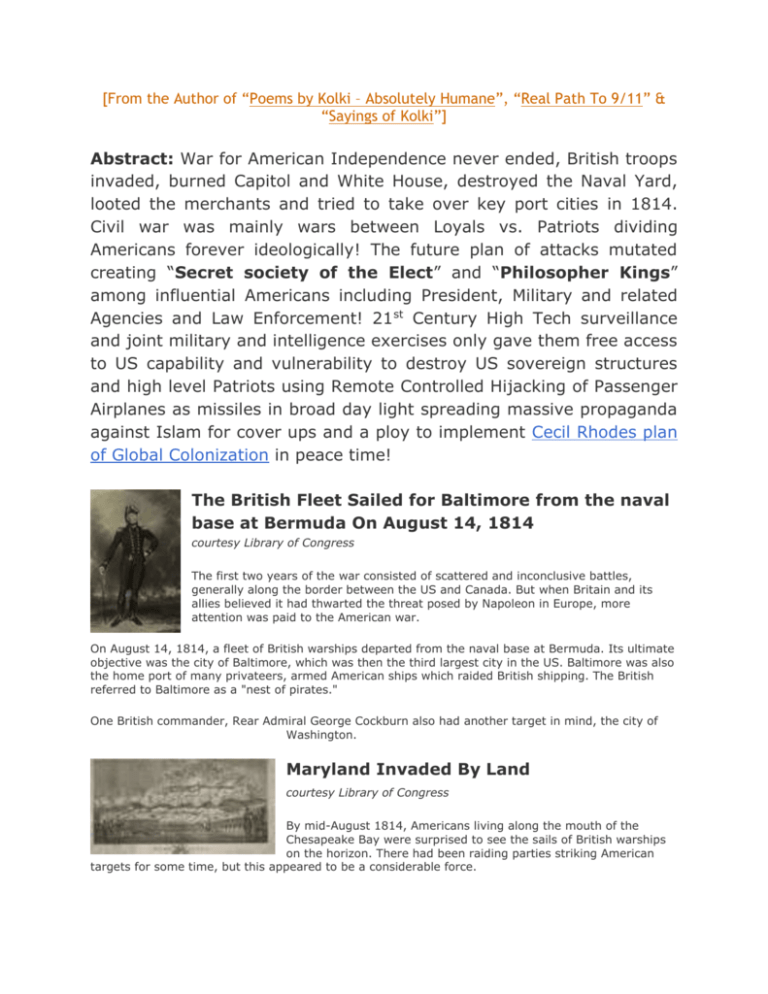
[From the Author of “Poems by Kolki – Absolutely Humane”, “Real Path To 9/11” & “Sayings of Kolki”] Abstract: War for American Independence never ended, British troops invaded, burned Capitol and White House, destroyed the Naval Yard, looted the merchants and tried to take over key port cities in 1814. Civil war was mainly wars between Loyals vs. Patriots dividing Americans forever ideologically! The future plan of attacks mutated creating “Secret society of the Elect” and “Philosopher Kings” among influential Americans including President, Military and related Agencies and Law Enforcement! 21 st Century High Tech surveillance and joint military and intelligence exercises only gave them free access to US capability and vulnerability to destroy US sovereign structures and high level Patriots using Remote Controlled Hijacking of Passenger Airplanes as missiles in broad day light spreading massive propaganda against Islam for cover ups and a ploy to implement Cecil Rhodes plan of Global Colonization in peace time! The British Fleet Sailed for Baltimore from the naval base at Bermuda On August 14, 1814 courtesy Library of Congress The first two years of the war consisted of scattered and inconclusive battles, generally along the border between the US and Canada. But when Britain and its allies believed it had thwarted the threat posed by Napoleon in Europe, more attention was paid to the American war. On August 14, 1814, a fleet of British warships departed from the naval base at Bermuda. Its ultimate objective was the city of Baltimore, which was then the third largest city in the US. Baltimore was also the home port of many privateers, armed American ships which raided British shipping. The British referred to Baltimore as a "nest of pirates." One British commander, Rear Admiral George Cockburn also had another target in mind, the city of Washington. Maryland Invaded By Land courtesy Library of Congress By mid-August 1814, Americans living along the mouth of the Chesapeake Bay were surprised to see the sails of British warships on the horizon. There had been raiding parties striking American targets for some time, but this appeared to be a considerable force. The British landed at Benedict, Maryland, and began marching toward Washington. On August 24, 1814, at Bladensburg, on the outskirts of Washington, British regulars, many of whom had fought in the Napoleonic Wars in Europe, fought poorly equipped American troops. The fighting at Bladensburg was intense at times, but the Americans could not hold. The federal troops retreated, along with observers from the government including President James Madison. A Panic in Washington courtesy Library of Congress While some Americans tried desperately to battle the British, the city of Washington was in chaos. Federal workers tried to rent, buy, and even steal wagons to cart off important documents. In the executive mansion (not yet known as the White House), the president's wife, Dolley Madison, directed servants to pack up valuable items. Among the items taken into hiding was a famous Gilbert Stuart portrait of George Washington. Dolley Madison instructed that it had to be taken off the walls and either hidden or destroyed before the British could seize it as a trophy. It was cut out of its frame and hidden in a farmhouse for several weeks. It hangs today in the East Room of the White House. The Capitol Was Burned courtesy Library of Congress Reaching Washington on the evening of August 24, the British found a city largely deserted, with the only resistance being ineffective sniper fire from one house. The first order of business for the British was to attack the navy yard, which they burned. British troops next arrived at the US Capitol, which was still unfinished. According to later accounts, the British were impressed by the fine architecture of the building, and some of the officers had qualms about burning it. According to legend, Admiral Cockburn sat in the chair belonging to the Speaker of the House and asked, "Shall this harbor of Yankee democracy be burned?" The British Marines with him yelled "Aye!" Orders were given to torch the building. British Troops Attacked Government Buildings courtesy Library of Congress The British troops worked diligently to set fires inside the Capitol, destroying years of work by artisans brought from Europe. With the burning Capitol lighting the sky, troops also marched to burn an armory. At about 10:30 pm, approximately 150 Royal Marines formed up in columns and began marching westward on Pennsylvania Avenue, following the route used in modern times for inauguration day parades. The British troops moved quickly, with a particular destination in mind. By that time President James Madison had fled to safety in Virginia, where he would meet up with his wife and servants from the president's house. The White House and adjacent Treasury Building Were Burned courtesy Library of Congress Arriving at the president's mansion, Admiral Cockburn reveled in his triumph. He entered the building with his men, and the British began picking up souvenirs. Cockburn took one of Madison's hats, and a cushion from Dolley Madison's chair. The troops also drank some of Madison's wine and helped themselves to food. With the frivolity ended, the British Marines systematically set fire to the mansion by standing on the lawn and hurling torches through the windows. The house began to burn. The British troops next turned their attention to the adjacent Treasury Department building, which was also set on fire. The fires burned so brightly that observers many miles away recalled seeing a glow in the night sky. The British Carried Off Supplies courtesy Library of Congress Before leaving the Washington area, British troops also raided Alexandria, Virginia. Supplies were carried off, and a Philadelphia printer later produced this poster mocking the perceived cowardice of the merchants of Alexandria. With the government buildings in ruins, the British raiding party returned to its ships, which rejoined the main battle fleet. Though the attack on Washington was a grave humiliation to the young American nation, the British still intended to attack what they considered the real target, Baltimore. Three weeks later, the British bombardment of Fort McHenry inspired an eyewitness, attorney Francis Scott Key, to write a poem he called "The Star-Spangled Banner." Article: NewPearlHarbour (9/11 False Flag Operation Motives and Means) Related Poems: Intelligence Democratic Security Felons Exorcist Articles: <9/11 Truth Smoking Guns Silent? Remote Military Hijacking What is Al-Qaeda?> Secrecy Why Media Is [Did you know Covert Intelligence like MI6, CIA, ISI, CSIS, RAW etc. spends 95% of their time and money for setting up low-tech Patsies while their sophisticated unit commit the high-tech crimes for the United Monarchies guarded by Swiss Bank and Government Aided secrecy? Listen from the Horse’s Mouth: http://www.kolki.com/peace/Von-Buelow-Interview.htm] Article: British Business Man Cecil Rhodes Methodologies For Re- Annexation and Annexation of The New World! The War of 1812 The Battle of Baltimore The Attack on Fort McHenry Image of Fort McHenry The War of 1812 at Sea USS Constitution vs. HMS Guerriere The Chase and Escape of USS Constitution Related Articles August 24 - Today in American History The War Up North - American History The Continental Army - American History The Battle of Princeton - American Revolution Siege of Boston - American Revolution Siege of Boston War of 1812 American History Timeline - War of 1812 By Martin Kelly The War of 1812 American History Timelines War History Civil War Timeline 1803-1812 - British impress approximately 10,000 Americans forcing them to work on British ships. July 23, 1805 - British decide in Essex case that American traders who travel between neutral and enemy ports will allow for the seizing many commercial ships. January 25, 1806 - James Madison delivers report concerning British interference and impressment of sailors causing anti-British feelings to arise. August, 1806 - American minister James Monroe and envoy William Pinkney are unable to resolve the major problems between the British and Americans concerning commercial shipping and impressment. 1806 - The British blockade France; American ships are caught in the middle and the British seize approximately 1000 US ships. March 1807 - Thomas Jefferson receives the Monroe-Pinkney treaty but does not submit it to Congress because it represents a dismal failure for the Americans. June 1807 - The American ship Chesapeake is fired on by the British ship Leopard after refusing to be boarded. This creates an international incident. December 1807 - Thomas Jefferson attempts "peaceful coercion" of the British with his embargo but it results in economic disaster for merchants. 1811 - Battle of Tippecanoe - Tecumseh's brother (the Prophet) leads attack on William Henry Harrison's army of 1000 men. June 18, 1812 - America declares war against the British. This war is known as "Mr. Madison's War" or "The Second American Revolution." August 16, 1812 - U.S. loses Ft. Mackinac as the British invade American territory. 1812 - Three attempts are made by the U.S. to invade Canada. They all end in failure. 1812 - The USS Constitution ("Old Ironsides") defeats the HMS Guerriere. January 1813 - Battle of Frenchtown. British and Indian allies repel Kentucky troops in bloody fighting. The American survivors are killed in the Raisin River Massacre. April 1813 - Battle of York (Toronto). US troops take control of Great Lakes and burn York. September 1813 - Battle of Lake Erie. US forces under Captain Perry defeat a British naval attack. October 1813 - Battle of Thames (Ontario, Canada). Tecumseh is killed in a US victory. March 27, 1814 - Battle of Horseshoe Bend (Mississippi Territory). Andrew Jackson defeats the Creek Indians. 1814 - The British plan a 3-part invasion of US: Chesapeake Bay, Lake Champlain, & the mouth of Mississippi River. The British are eventually turned back at Baltimore harbor. [ August 24-25, 1814 - The British burn Washington, D.C. and Madison flees the White House. September 1814 - Battle of Plattsburgh (Lake Champlain). The US secures its northern border with a huge victory over a larger British force. December 15,1814 - The Hartford Convention occurs. A group of Federalists discuss secession and propose seven amendments to protect the influence of Northeastern states. December 24, 1814 - Treaty of Ghent. The British and American diplomats agree to return to the status quo from before the war. January 1815 - Battle of New Orleans. Andrew Jackson scores a huge victory and paves the way to the White House. 700 British are killed, 1400 are wounded. The US only loses 8 soldiers. See More About war of 1812 james madison james monroe andrew jackson 1803-1812 - British impress approximately 10,000 Americans forcing them to work on British ships. July 23, 1805 - British decide in Essex case that American traders who travel between neutral and enemy ports will allow for the seizing many commercial ships. January 25, 1806 - James Madison delivers report concerning British interference and impressment of sailors causing anti-British feelings to arise. August, 1806 - American minister James Monroe and envoy William Pinkney are unable to resolve the major problems between the British and Americans concerning commercial shipping and impressment. 1806 - The British blockade France; American ships are caught in the middle and the British seize approximately 1000 US ships. March 1807 - Thomas Jefferson receives the Monroe-Pinkney treaty but does not submit it to Congress because it represents a dismal failure for the Americans. June 1807 - The American ship Chesapeake is fired on by the British ship Leopard after refusing to be boarded. This creates an international incident. December 1807 - Thomas Jefferson attempts "peaceful coercion" of the British with his embargo but it results in economic disaster for merchants. 1811 - Battle of Tippecanoe - Tecumseh's brother (the Prophet) leads attack on William Henry Harrison's army of 1000 men. June 18, 1812 - America declares war against the British. This war is known as "Mr. Madison's War" or "The Second American Revolution." August 16, 1812 - U.S. loses Ft. Mackinac as the British invade American territory. 1812 - Three attempts are made by the U.S. to invade Canada. They all end in failure. 1812 - The USS Constitution ("Old Ironsides") defeats the HMS Guerriere. January 1813 - Battle of Frenchtown. British and Indian allies repel Kentucky troops in bloody fighting. The American survivors are killed in the Raisin River Massacre. April 1813 - Battle of York (Toronto). US troops take control of Great Lakes and burn York. September 1813 - Battle of Lake Erie. US forces under Captain Perry defeat a British naval attack. October 1813 - Battle of Thames (Ontario, Canada). Tecumseh is killed in a US victory. March 27, 1814 - Battle of Horseshoe Bend (Mississippi Territory). Andrew Jackson defeats the Creek Indians. 1814 - The British plan a 3-part invasion of US: Chesapeake Bay, Lake Champlain, & the mouth of Mississippi River. The British are eventually turned back at Baltimore harbor. [ August 24-25, 1814 - The British burn Washington, D.C. and Madison flees the White House. September 1814 - Battle of Plattsburgh (Lake Champlain). The US secures its northern border with a huge victory over a larger British force. December 15,1814 - The Hartford Convention occurs. A group of Federalists discuss secession and propose seven amendments to protect the influence of Northeastern states. December 24, 1814 - Treaty of Ghent. The British and American diplomats agree to return to the status quo from before the war. January 1815 - Battle of New Orleans. Andrew Jackson scores a huge victory and paves the way to the White House. 700 British are killed, 1400 are wounded. The US only loses 8 soldiers. Related Articles Definition of Impressment of Sailors War of 1812 Causes - Causes of the War of 1812 Birth of the United States Navy - American Revolution The Country's Economy - American History Naval Warfare - American Revolution Why 9/11 military coup was symbolically Re-Annexation of the United States of America by the United British Monarchy to be a Hyperpower to colonize world resources in peace time? "If USA is really serious about democratizing the world, why not start with The United Kingdom, the main colonizing force, its tributaries1 (including Norway, Sweden, Denmark, Belgium, Netherlands, Spain, Australia, Canada, New Zealand, and Luxembourg) and accessories (including Saudi Arabia, Qatar, Dubai, Kuwait, Oman, Jordon, Bhutan, and Japan). Last but not least USA must have a Central Election Commission and all Senators must be chosen by elections to eradicate Philosopher Kings whose allegiance are to The United Kingdom of Israel.” Kolki Easy Methodology To End Constitutional Monarchies Peacefully in the West To Save And Maintain Democracies Around The World!
